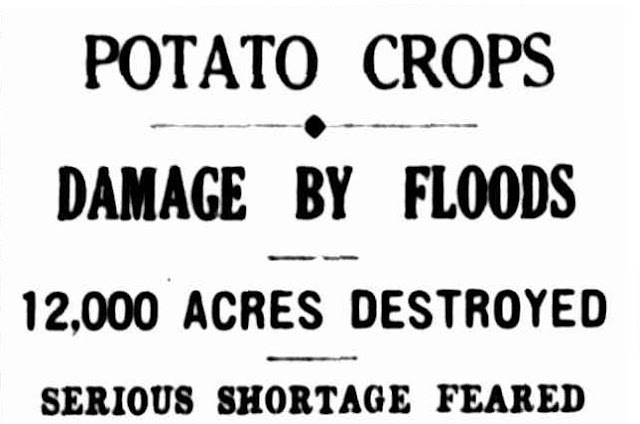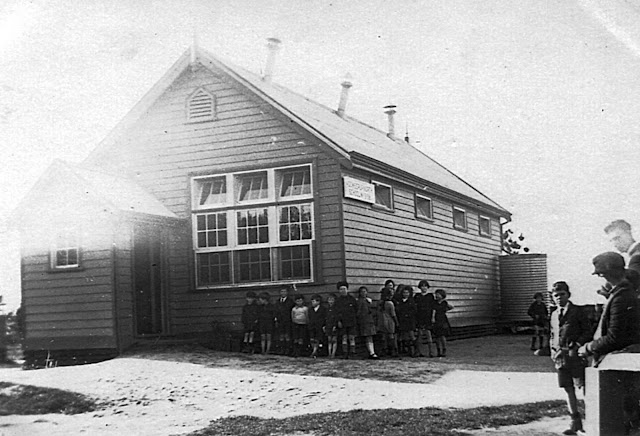TOLL OF DISASTROUS FLOODS
MANY DEAD; THOUSANDS HOMELESS
DESOLATION IN GIPPSLAND
KOO-WEE-RUP TOWNSHIP EVACUATED
YARRA CAUSES UNPRECEDENTED DAMAGE
Many lives were lost and thousands of persons were rendered homeless during the week-end in the most disastrous floods ever known in Victoria. Damage done to property is beyond calculation.
Koo-wee-rup township was overwhelmed when flood waters burst the main channels through the swamp and inundated 20 square miles of closely settled farming country. Six persons were drowned, and about 2,000 persons are homeless. The township was evacuated, four relief trains carrying refugees to various centres. Many persons clung to the roofs of their homes for hours before they were rescued.
In many other parts of Gippsland the flood waters rose, rolling over farm lands, submerging homes, and bringing desolation and distress to hundreds of homes.
Countless deeds of heroism were performed in rescuing the victims of the floods. A party of fishermen from Lakes Entrance, with police, rowed for miles in swiftly flowing, debris-filled water in the Moe and Trafalgar districts, and saved many lives.
Distress scarcely less acute was suffered in the metropolitan area. At Chelsea 1,500 persons are homeless. About 600 women and children were rescued in boats and lorries. Many of the residents affected were aged or ill.
The River Yarra rose to unprecedented levels and caused untold damage to property. At Warrandyte 40 houses had to be vacated. About 300 persons at Richmond and residents at many other suburbs along the river had to leave their homes.
RESIDENTS OF KOO-WEE-RUP SPEND NIGHT ON ROOFS
Feared That Six Lives Were Lost
TOWN EVACUATED; SPECIAL TRAINS FOR VICTIMS
(By Our Special Reporter.)
Bursting the main drainage channels through the Koo-wee-rup Swamp, flood waters from the hill country to the north Inundated about 20 square miles of closely settled farming country on Saturday morning and flooded the township of Koo-wee-rup. Six persons have been drowned and 2,000 others are homeless. The water rose at the rate of about 1ft. a minute.
The township has been evacuated, and four relief trains sent from Melbourne have carried the residents away from the flooded area. Several hundreds were taken to Dandenong, and others went to other areas of safety, some even to Melbourne where they were quartered. The flood is the most disastrous that has occurred in the district.
Two men, both thought to be farmers, were drowned near Bunyip. They were Councillor John Dowd, formerly president of the Berwick Shire, and a man whose, name was Jolly. George Wilson, of Iona who was drowned near Garfield. The body of a man named Williams was recovered at Garfield yesterday morning by Constable Jordan. The body of John Samwell, aged about 55 years, sustenance worker, was seen by Mr John Hickey being carried by the flood waters toward the main drain in the Koo-wee-rup Swamp. Mr Hickey, who is aged 70 years, was rescued after he had clung to a tree for 28 hours. Gordon Nash, aged 14 years, of Tonimbuk, was drowned in Diamond Creek.
Following heavy rain, which fell during Friday night, there was about 3 inches of water in the streets of the town at 8 a.m. on Saturday. The water rose so rapidly that in three-quarters of an hour its depth had increased to 7ft., and the residents of Koo-wee-rup were trapped almost without warning. It continued to rise until every single-story house was covered, and only the roofs of two-story buildings remained above water by early afternoon. As the waters rose the towns-people removed their furniture to the lofts
of their homes, but their efforts to save their property were futile, and few of them are known to have escaped with more than their lives. They had to rush from their houses and climb to the roofs, where they had to cling for hours before they could be rescued. Many of them had harrowing experiences. A large number were able to reach the station platform, where there was comparative safety, before the water became too deep for them to wade. Here they built rafts from logs and gathered boats with which they rescued as many people as possible.
The residents of Dandenong have provided clothing and shelter for more than 200 people who have been brought to them. At Dandenong refugees have been billeted with many of the residents of the town, and in the Armitage Scout Hall. Many others are in private hospitals, some of them suffering seriously from shock, exposure, and immersion. Very few of the rescued persons escaped without suffering lacerations and abrasions during the battering they received from the flood waters while on the roofs of their houses. Many families have become separated, and parents who are safely accommodated do not know whether their children are alive.
Small Girl's Escape
At 7.30 a.m. on Saturday a small girl walked out of her house on to the road where the water was a foot deep. She walked 200 yards to the railway station to give an alarm. When she reached the station the water was up to her neck. In some places the water soon rose to a depth of 30ft., covering the house-tops of settlers on the swamp and wrecking their homes. According to farmers, horses and cattle were carried by the floods toward Westernport Bay. Thousands of cattle and sheep were drowned. In Koo-wee-rup dead cows were swept into the houses.
One of the main channels draining the swamp is at Cora Lynn, the other is at Yallock Creek, two miles away. As the water rose drains broke and the flood swept over the country. The waters are spreading toward Lang Lang. Dairy farmers on the swamp, many of whom have up to 100 head of cattle, have lost all their animals. Potato fields have been ruined.
Food and Blankets for Homeless.
Blankets, bread, and tinned meat were rushed to Dandenong by the State Relief Committee. Residents of the town, however, rose to the occasion magnificently and provided shelter, food, and clothing for the sufferers. Half-naked men and women who have arrived are to be given every possible care. There was about a foot of water in the main street of the township late last night. Cuts have been made in the rail way embankment, which has prevented the escape of water to the bay, and the flood is now running down to the sea.
Water Infested With Snakes
Saturday night was a night of terror for the persons marooned on the housetops. The waters were infested with hundreds of swimming snakes, which tried to reach the roofs. The stranded persons had to fight them off with sticks as well as try to keep themselves above the level of the flood.
Koo-wee-rup Hospital was flooded to a depth of 7ft within a few minutes, and the patients, some of whom were seriously ill, were trapped before they could be moved. Mr Clarence Renner, who had undergone an operation for appendicitis a few hours beforehand, was in bed, and unable to help himself. His father, who was on the railway platform, waded and swam through the swirling water to the hospital, and climbed on to the roof, where with the the assistance of Mr Gannon, he cut a hole in the galvanised iron and pulled his boy to safety up through the hole. Aided by others who came to the rescue, the 10 remaining patients in the wards were taken out in the same manner.
Heroism and Fortitude
Mrs Mary Ann Bolleman, aged 59 years another patient held a baby in her arms above the water for 15 hours with the water surging above her neck before they were rescued. Mrs A. Adams and her baby which was born only the night before were being pulled out when the child was dropped into the water. She grasped the child's clothing frantically and saved it from drifting away. Both were raised through the opening to safety. Joseph Lee an elderly man was caught unawares by the water while in an open paddock but after being swept for some distance was able to scramble to safety on the roof of a shed. He was joined by another man. After remaining on the roof for several hours with the water surging round them, Lee's companion, whose name is not known, was carried away and drowned, but Lee remained there for 30 hours and was in a state of collapse when rescued. He was placed in Murray House private hospital, at Dandenong, where is is suffering from shock and exposure. His condition is serious. Mr. J. F. Brewer chemist of Koo-wee-rup, with his wife and two children, were caught almost unawares. Seizing a few clothes hurriedly they climbed to the top of the shop, where they stayed for several hours before they could be taken off.
The residents of Dandenong made a magnificent response to appeals to accommodate the refugees. The day before Koo-wee-rup was evacuated they had been engaged in rescuing persons and property from any houses in their own district which had been flooded. On Saturday night only straw mattresses and blankets were available for the victims, many of whom were dressed only in their night clothes. Last night every woman had been provided with a bed in the homes of residents of the town. The men slept in the Scout Hall, but under much better conditions. Admirable co-operation by the townspeople enabled sufficient food to be obtained for them.
Many Refugees at Garfield
A report from Garfield last night stated that hundreds of people are homeless there and were taking refuge in the Mechanics' institute and the hotel. Rescues were effected by police from barns and isolated houses. Mr. Patrick Brennan a resident of the town has been missing since Friday night, and as his horse and jinker have been found fears are felt for his safety.
The telephone operator at the Koo-wee-rup post-office remained on duty at the switchboard until the water entered his office and washed the switchboard away.
Drowned While Asleep
George Wilson an old-age pensioner of Iona near Garfield, was found dead in his hut, which adjoins the main drain It is believed that he was drowned while asleep. Gordon Nash, aged 14 years of Tonimbuk was drowned in Diamond Creek. His body was swept downstream and disappeared.























